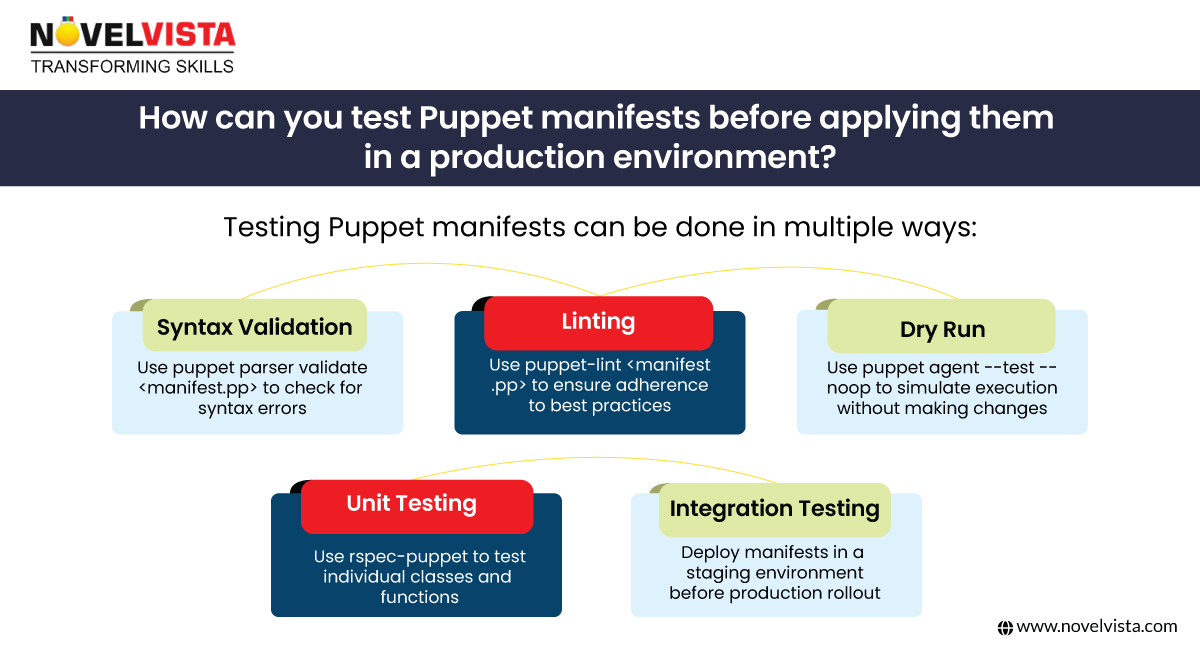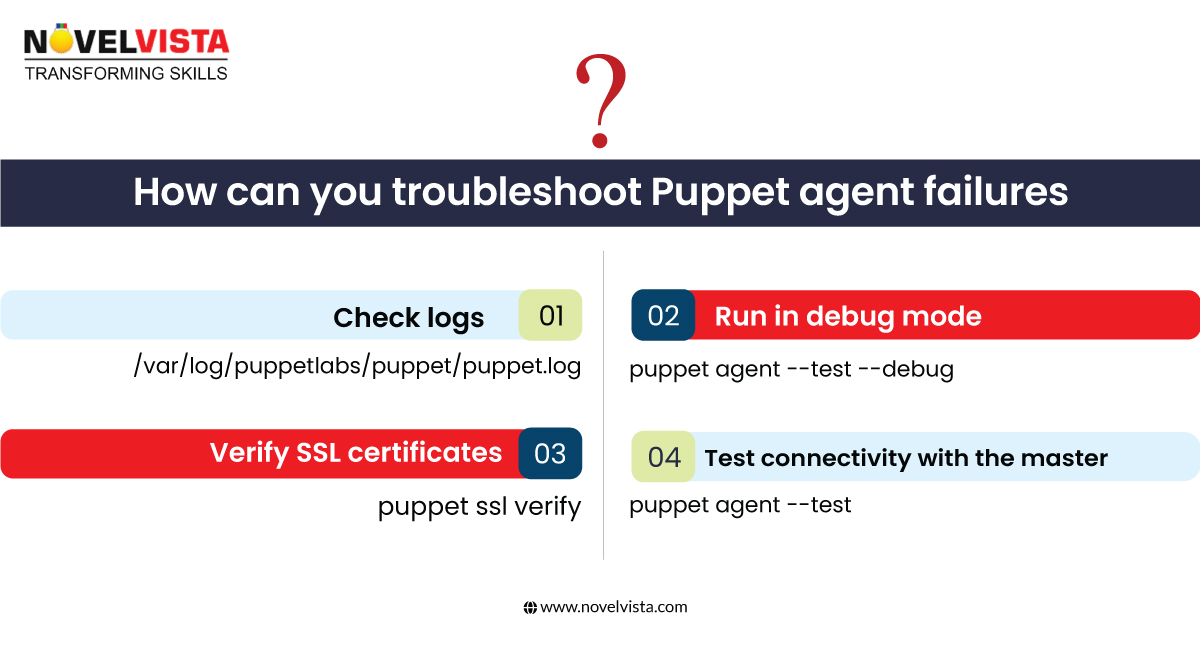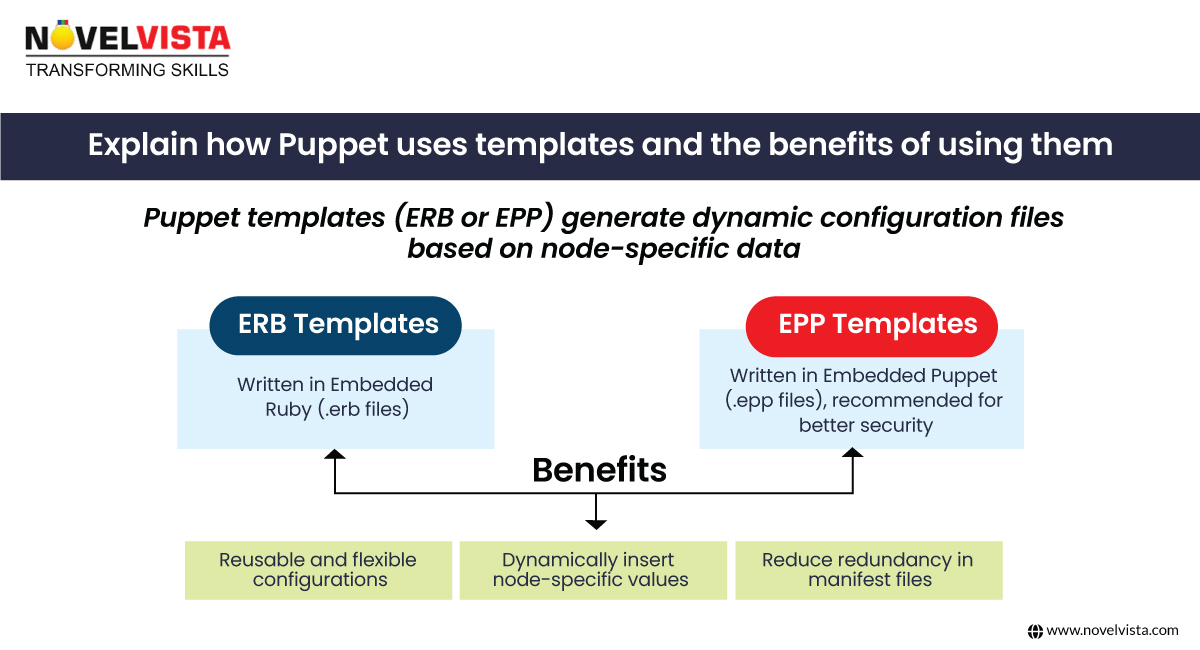What is the significance of the name Puppet?
Well, who knows?
But all we know is that it surely does a lot more than just be a puppet.
Puppet consists of a custom declarative language to describe system configuration, which can be either applied directly to the system or compiled into a catalog and distributed to the target system via theclient-server paradigm, and the agent uses system-specific providers to enforce the resource specified in the manifests. The resource abstraction layer enables administrators to describe the configuration in high-level terms, such as users, services, and packages, without the need to specify OS-specific commands.
And the result of the same is huge! It ends up helping in deploying, managing, and configuring your servers and mostly, contributing to your DevOps culture. Isn’t that amazing?
Being the favorite tool of so many organizations, it is quite obvious that Puppet will throw a hell lot of interview questions your way.
Top 50 Puppet Interview Questions and Answers
1. What is Puppet?
Ans:Puppet is a configuration management tool that is broadly used for automating administration tasks. The puppet tool contributes to DevOps culture by deploying, managing, and configuring your servers.
2. What are manifests?
Ans:The manifests are some files in Puppet where the client configuration is specified.
3. What is the difference between a Module and a Manifest?
Ans:The manifests that are defined in modules can be included in the manifests, making it easier to manage the modules Also, the chosen manifest can be pushed on the specific agent or node.
4. What is Facter?
Ans:The Facter is a system profiling library that is used to gather system information during a puppet run. The Facter provides you with information regarding the IP address, version of the kernel, CPU, and others.
5. What is a puppet kick?
Ans:Puppet Kick allows you to trigger the puppet agent from Puppet Master during the run interval when the Puppet Agent sends a request to Puppet Master.
6. What is MCollective?
Ans:The MCollective is a tool developed by Puppet Labs for server orchestration. MCollective runs thousands of jobs simultaneously, using your own or existing plugins.
7. is it possible to manage workstations with Puppet?
Ans:Puppet tool can be used for managing machines like laptops, desktops, and even workstations.
8. Does Puppet run on Windows?
Ans:Beginning with Puppet 2.7.6, it is possible to run on Windows and this ensures future compatibility.
9. What type of organizations can use Puppet?
Ans:An organization with a huge number of servers can benefit from Puppet since it eliminates the need for manual management of the servers.
10. Can Puppet run on servers that are unique?
Ans:Puppet can run on unique servers. Although there might be fewer chances of servers being unique since within an organization there are a lot of similarities that exist, like the operating system that they are running on.
11. What are puppet labs?
Ans:Puppet Labs is a company interested in solving the Puppet automation problem.
12. How can you test Puppet manifests before applying them in a production environment?

13. How do I upgrade Puppet and Facter?
Ans:You can upgrade Puppet and Facter by your operating system package management system in 2 ways:
- Through the vendor’s repository
- Through the Puppet Labs’ public repositories
14. What are the characters permitted in a class and module name?
Ans:The characters that are permitted in a class and module name are:
- Lowercase letters
- Underscores
- Numbers.
15. How are the variables like $ operating system set?
Ans:You can set variables like $ with the help of Facter.
16. What happens if you don’t sign a CLA?
Ans:If you don’t sign a CLA, code contributions to Puppet or Facter can’t be accepted. Puppet users can log in to their GitHub account to sign the agreement on the CLA page.
17. What is the codedir in Puppet?
Ans:The codedir in Puppet is the main directory that stores Puppet data and code. The code directory contains environments in which manifests and modules reside.
18. Where is the codedir configured in Puppet?
Ans:The puppet.conf is ideal for configuring the location of the codedir with the codedir setting. Puppet Server uses its JRuby-puppet.master-code-dir setting along with the puppetserver.conf.
19. What is Hiera?
Answer:Hiera is a built-in key-value lookup ideal to separate the data from Puppet code. Hiera also stores configuration data in key-value pairs and is ideal for finding out the data needed by a specific module for a given node.
20. What are Virtual Resources in Puppet?
Ans:Virtual resources in Puppet are instruments that specify a particular state of a resource. Although virtual resources don’t demand the implementation of a specific state for the resource,
21. How can you troubleshoot Puppet agent failures?

22. Is Puppet suitable for managing workstations?
Answer: A puppetis an ideal tool for managing almost any machine. Hence, puppet proves to be a major tool for managing various organizations that have various systems.
23. What is Puppet Kick and how do we use it?
Answer:What is Puppetmight confuse you a bit as it has different applications and uses. It's the command that can trigger a Puppet agent from the Puppet master. At the end of the regular run interval, the puppet agent sends a request to the Puppet master. But with Puppet kick, we can trigger this process manually so that the agent contacts the master and immediately fetches any configurations that may be due.
24. Can Puppet manage workstations?
Answer:Yes, managed workstations with Puppet. On the whole, even though servers might be different and peculiar to the organization, most workstations share an operating system. This means that Puppet would be able to maintain those systems and, apart from keeping them consistent across every machine in the organization, would automate compliance even more.
25. What is MCollective, and how does it enhance Puppet's capabilities?
Answer:MCollective, the Marionette Collective, is an orchestration technology from Puppet Labs to allows you to run action on thousands of servers at once, said by either of its existing plugins or one's own. Such parallel job execution enhances Puppet's intrusiveness to manage large-scale infrastructures.
26. How does Puppet handle a unique server for an organization?
Answer:Puppets can still be of use, even in servers with different configurations. While there would be differences like different IP addresses or hostnames, they most likely run on fairly standard OS. These configurations can be made in Puppet itself, which would allow it to handle all these unique aspects of a particular server while treating all servers fairly alike.
27. What is the functioning of Facter in Puppet?
Answer:Facter is used for this system profiling library to bring the information from the system together during a run of Puppet. This has information not only on the IP address and kernel version but also on the CPU and others, which are very strategic parts for targeting Puppet decisions about specific manifests as well as applying these configurations based on system characteristics.
28. How does Puppet manage dependency between resources?
Answer:Dependency between resources is achieved in Puppet using some relationship meta parameters such as before, require, notify, and subscribe. These ensure that resources are applied in the correct order.
29. What is the file puppet.conf?
Answer:This file contains the main configuration settings for Puppet, and these are settings used to determine how the agent and master communicate with each other or the server addresses, environment settings, and other operational parameters.
30. What is the theory of 'idempotency' in Puppet?
Answer:If the same Puppet code is applied multiple times, it will always have the same result on the system regardless of the number of applications of that code. This is what idempotency means that there won't be discrepancies with how the resource will be applied going forward.
31. Explain how Puppet uses templates and the benefits of using them.

32. What does Hiera do in Puppet?
Answer:Separating the data from the code, Hiera will give Puppet to look up data in a key-value way. So territory of configuration data would be handled more hierarchically, thereby resulting in better abstractions when writing Puppet code.
33. How do you store secrets and sensitive data with Puppet?
Answer:According to Puppet documentation, to store sensitive information securely, use Hiera along with a suitable backend such as the eyaml backend. For instance, the eyaml backend provides a way to encrypt sensitive data and store it securely so that it can be read by only authorized users or systems.
34. Explain the role of the Puppet master.
Answer:The Puppet master is the central server that compiles catalogs for each node, manages modules and manifests, and stores configuration data. It is considered the authoritative source of configuration information in a Puppet environment.
35. How does Puppet guarantee the desired state of an operating system?
Answer:Puppet guarantees the desired state by continuously enforcing the configurations defined within manifests. The mimicry of the desired state from the current state of the system, followed by changes applied towards achieving and maintaining this desired state, is how Puppet carries itself.
36. Puppet modules: what are they as well as their structure?
Answer:Puppet modules are collections of manifests, files, templates, and other resources organized in a specific directory structure. The structure includes directories like manifests, files, templates, and tests, promoting the reusability of your Puppet codes.
37. What is the way of testing Puppet code?
Answer:Testing your puppet code would require using the tools for syntax checking and style-giving purposes, such as puppet-lint, or unit testing code with actual rspec-puppet. Both tools ensure that your Puppet code is in good shape, maintainable, and usable according to best practices.
38. What’s Better When It Comes To Chef vs Puppet?
Answer:Chef vs Puppetare both prominent configuration management tools used to automate the deployment, configuration, and management of different applications. They have common goals of streamlining IT operations that include language and approach, architecture, scalability, community and ecosystem, etc. The choice between Chef vs Puppet is hopefully based on the specific requirements of an organization, the existing skill sets of the team, and the complexity of the infrastructure
39. What about service management from the perspective of Puppet?
Answer:The service management aspect in Puppet is governed by the service resource type. Based on one's definition of the desired state of service i.e. running, stopped, enabled, or disabled, Puppet ensures that, on the target system, its state corresponds to that which has been specified.
40. What is a Puppet agent?
Answer:The Puppet agent is the agent running on each managed node. It communicates with the Puppet master, receives the compiled catalog, and applies the configurations to the local system that ensure its state matches the desired one.
41. How to manage Puppet environments?
Answer:Puppet is capable of running multiple environments with each having different configured parameters; in other words, different configurations can be set for each environment. This is typically done by organizing separate directories for each environment and configuring the environment path in the puppet.conf file.
42. What does Puppet Cert do?
Answer:The Puppet cert command is aimed at managing SSL certificates in a Puppet environment; this includes listing, signing, and revoking certificates that subsequently qualify the security of communication between the master and agent nodes.
43. How does Puppet handle file-related issues?
Answer:Puppet manages file access using the file resource type. You can define the desired state of any file as to its content, permissions, and ownership, and Puppet will ensure that the target system will have the file in the indicated state.
44. Puppet's ENC is an External Node Classifier and is used for what?
Answer:ENC supports dynamic node categorization based on an external data source e.g. database, CMDB, etc. It is beneficial mainly for large-scale environments where nodes need specific configurations based on business logic.
45. When does Puppet configure for configuration drift?
Answer:When settings in the system deviate from the established state of affairs, configuration drift occurs. Here is what Puppet does to handle this:
- Puppet runs at the default time interval, which is about 30 minutes.
- Puppet could detect changes violating an enforced state.
- Difference logging for audit and compliance.
46. How do you debug Puppet manifests?
Answer:Some methods of debugging using Puppet are:
- Using puppet parser validate to check for syntax errors
- Running puppet apply --debug for detailed logs
- Using puppet resource to look into the system configurations
47. Why would one export resources in Puppet?
Answer:Export resources refer to the ability to allow nodes to share configuration data using the PuppetDB. They are used for easy management of interdependent services and enable dynamic resource discovery.
48. Explain how Puppet integrates with cloud platforms like AWS and Azure.
Answer:Puppet integrates with cloud platforms using the following plugins and modules:
- AWS:The puppetlabs/aws module manages EC2 instances, S3 buckets, and security groups.
- Azure:The puppetlabs/azure module installs virtual machines and storage/network configurations in Azure.
49. What are custom facts in Puppet, and how do you create one?
Answer:A custom fact is a user-defined property of a system with more information than it has from Facter. Custom facts are written in Ruby and placed in the lib/facter directory.
50. How does Puppet ensure the high availability of its master nodes?
- The high availability feature of Puppet is achieved through the use of multiple Puppet Masters in a load-balanced architecture.
- HAProxy or Nginx serves as a load balancer controlling requests and distributing them.
- A shared backend using PostgreSQL ensures consistent data on all Puppet Masters.
- Failure of one Puppet Master causes agents to communicate with another Puppet Master.
51. How does Puppet manage packages, and what advantages does it have?
Answer:Puppet manages packages via the package resource type. It permits administrators to install, upgrade, or remove software on a multitude of nodes.
Provides the following benefits:
- Ensures installation and up-to-date software.
- Supports multiple package managers including apt, yum, and chocolatey.
- Automated package updates and reduced manual work.
52. What is Puppet Forge in the Puppet ecosystem?
Answer:Puppet Forge is an online storage of pre-built modules created by the Puppet community and Puppet Labs. This is reusable code to quickly and efficiently manage applications, infrastructure, and configurations.
53. What is the difference between Puppet Apply and Puppet Agent?
Answer:Puppet Apply runs standalone and is meant for one-off runs and testing. Puppet Apply is a local configuration without the need for a Puppet master. Puppet Agent works in a client-server mode and continually enforces configurations by communicating with the Puppet Master. puppet apply site.pp is used for standalone execution, while puppet agent test retrieves configurations from the master.
Moving Forward
Puppet Apply is a standalone execution mode used for one-time runs, testing, and local configurations without needing a Puppet Master, making it a common topic in Puppet interviewdiscussions. In contrast, Puppet Agent follows a client-server model, continuously enforcing configurations by communicating with the Puppet Master. At NovelVista, mastering these Puppet concepts helps professionals streamline IT automation and configuration management efficiently.
Get certified with the DevOps Foundation Training & Certification and fast-track your career in automation and infrastructure management.
Conclusion:
Wish to learn puppetry beyond these interview questions as well as get practical knowledge about it? Try joining our DevOps courses and learn all of it then!
Author Details

Akshad Modi
AI Architect
An AI Architect plays a crucial role in designing scalable AI solutions, integrating machine learning and advanced technologies to solve business challenges and drive innovation in digital transformation strategies.
Confused About Certification?
Get Free Consultation Call









